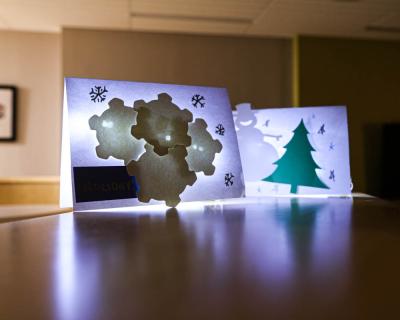Follow along to learn how to make a light-up winter card! Watch the video then use the step-by-step instructions listed below for additional guidance in creating your card! This project uses supplies included in our Light-Up Winter Card: A Take & Make Teen program. If you weren't able to snag a kit you can still create a card, you'll just need the supplies listed below!
Supplies included in the Take & Make Teen kit:
- Pre printed Cardstock paper Circuit Template
- 2032 3v Coin Cell Battery
- About 2-3’ Conductive Copper Tape
- 4 LEDs
- A Piece of transparency
- Assorted Cardstock Shapes
- And the Paperclip that attached the bag to the template
Additional supplies needed:
- Clear Tape
- Scissors
- A sharp knife
- Permanent Marker
- Drawing Materials, etc.
Step 1: Test the LEDs
If you look at the LEDs you’ll notice that it looks like a little bulb with two wires, also known as leads, emerging from it. One of the wires is longer than the other. The longer of the two leads is known as the anode or positive lead. The shorter of the two is called the cathode or negative lead. Electricity only can flow in one direction through this part, from the anode to the cathode or from positive to negative. We call components which work only in one direction “polarized”
The battery is also polarized. On the top of the coin cell battery, you should see a + sign. This is the positive side of the battery. The negative side is not marked.
We can create a simple circuit and test our LEDs in the process by connecting the + side of the LED to the + side of the battery, and the - side of the LED to the - side of the battery. The easiest way to do this is to take your battery and insert it between the two leeds of the LED, with the longer leed on the top part of the battery and the shorter on the rough underside. It should light up! If it doesn’t try flipping the LED around and reinserting the battery. Do this for all of your LEDs. Experiment, try putting more than one LED on? What happens?
Step 2: Create Your Paper Circuit
Included in this kit is a couple of feet of conductive copper tape. Conductive means in this case that you can use it to transmit electricity. We are going to create a circuit to provide power to light up our LEDs to use them as decoration for a fun, light-up wintery card.
We’re going to take out tape and stick it to the cardstock, following the pattern laid out here. This pattern is just like the ones used in conventional circuits, just a lot bigger, and we call these copper patterns traces. Our circuit consists of two traces, one of them leading from the positive side of the battery to the positive sides of our LED, and the other from the negative side of our battery to the negative side of the LEDs.
It is important that these traces never touch. If they do, this will cause a short circuit, and drain the battery prematurely. In general, it's better to use one strip of copper tape per a trace if you can, removing the backing as you go and sticking it down and folding it to get around corners. Many smaller strips may look neater, but can cause failures in the circuit if they are not joined properly and usually are not worth it.
After you’ve got your traces laid down, fold up the bottom corner of the card along the dotted line. Place the battery on the dotted circle with the + side facing up. Tape just the edges of the battery down, if you cover it in tape it will not work. Now when you press down on the folded over portion, electricity can flow through your circuit.
Take one of your LEDs, and splay out the two leads in opposite directions, making sure that you remember which one was longer. I often find it helpful to add a small mark onto this lead with a permanent marker.
I like to be able to test my LEDs as I go to make sure I put them on the right way, so I use the paper clip to hold down the flap to the battery so that the circuit is always on. Make sure you have a good connection, and that the copper tape is being securely held to the battery.
Now take your LED and hold it across the two traces you have just made, with the longer of the two leads on the + trace and the shorter on the - trace. Hold it to the traces with your fingers, don’t worry, the amount of electricity that the battery can put out will not harm you when used like this. Press down on the battery flap, does the LED light up? If not, try flipping the LED around.
If it doesn’t work, check your traces, are they touching anywhere? Are they broken? Is the negative trace go underneath the battery? Does the positive trace touch the battery and not the tape holding the battery down? Is the battery flap securely held by the paper clip? Carefully inspect your circuit, and if trouble still persists, remove and test out the battery again with another LED.
Once you have your LED lighting up, consider using the paperclip to keep your circuit live while constructing the rest of the circuit. That way if there is a problem, you’ll know right away.
Ok, so now we’re going to attach the LEDs to the traces at the locations indicated on the template using the remaining copper tape.
I find that it works best to have the leads cross the copper trace and then to tape each of the LED’s leads to the traces with a small pieces of copper tape. I then use clear tape to secure the whole thing to the card.
Once you have your first LED in place, repeat the process of taping each of your LED’s leads to the appropriate trace, either positive for the longer leg, or negative for the shorter leg, making sure that they each light up.
Congratulations, you’re done with the electronics portion of this craft!
Step 3: Decorate!
Now for the creative part, You can decorate this card however you want, but we’ve included some supplies to make a card with a neat popup, backlit effect. The first thing we need to do is to cut out these areas so that the LEDs can protrude from the front of the card. Start by folding the card in half on the dotted line.
Use your knife or another sharp implement to poke holes in the top part of the card so that the LEDs can protrude from the front of the card. Fold the card over to make sure the LEDs do poke out of these holes.
In the kit there will be several precut shapes, either snowflakes or trees or circles (ornaments). We’re going to raise them a bit above the LEDs, by making som pop-up supports out of the strip of clear acetate in your kit.
We will be making these strips in pairs, to evenly support the cut out shape. To make them the same length, fold the acetate strip in half and cut them both at the same time. I made most of mine about ¾” of an inch long, but feel free to improvise.
You are going to want to fold these into pairs of ‘z’ shapes. I did this by first folding them in half and then folding one side in half again the opposite direction. You then want to apply a bit of tape to them so that you can stick one side of them to the back of the shape, and the other to the card. I found it helpful to put both pieces of tape on at the same time, Take your cardstock shape and stick it down to the card, covering one or more of the LEDs. When you turn the LEDs on, you should see a neat, backlit effect!
Do this for all of the shapes, overlapping them as you please. I added some other elements after I got my shapes on there, so feel free to get creative!

Now you’ve made yourself a fun, light up wintery card! Congratulations on your paper circuit!
Did you like this craft? Be sure and show us what you made. We’re on Instagram or join our new teen Discord and share it with us there! Thanks!
